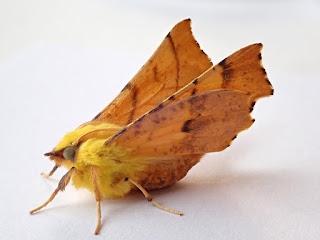(15th) Blastobasis adustella, Epagoge grotiana, Eucosma campoliliana, Cydalima perspectalis, Large Twin-
spot Carpet, Buff Footman, Svensson's Copper Underwing, Slender Brindle
(16th) Agonopterix alstromeriana, Anarsia innoxiella, Mompha propinquella, Stenoptilia pterodactyla, Lesser
Cream Wave, Plain Pug, Tree-lichen Beauty, Obscure Wainscot
(17th) Zelleria hepariella, Ypsolopha scabrella, Oncocera semirubella, Oak Hook-tip, Straw Underwing,
Small Wainscot
(18th) Epinotia nisella, Slender Pug, Maple Pug, Canary-shouldered Thorn, September Thorn, Black Arches
(19th) - nil -
(20th) Bryotropha domestica, Acleris variegana
(21st) Oegoconia sp, Notocelia rosaecolana, Catoptria falsella, Wormwood Pug, Magpie Moth
 |
| Oncocera semirubella, Westcott 17th July |
 |
| Canary-shouldered Thorn, Westcott 18th July |
 |
| Magpie Moth, Westcott 21st July |
Dave Wilton
Westcott, Bucks

I wonder how long it will take Cydalima perspectalis to reach you in numbers. My first was also in 2017, October, but they are now one of the more regular moths in the trap with double figures on many nights this year.
ReplyDelete